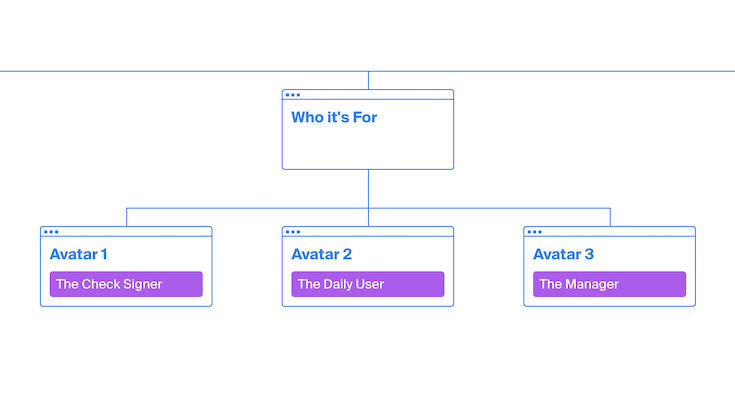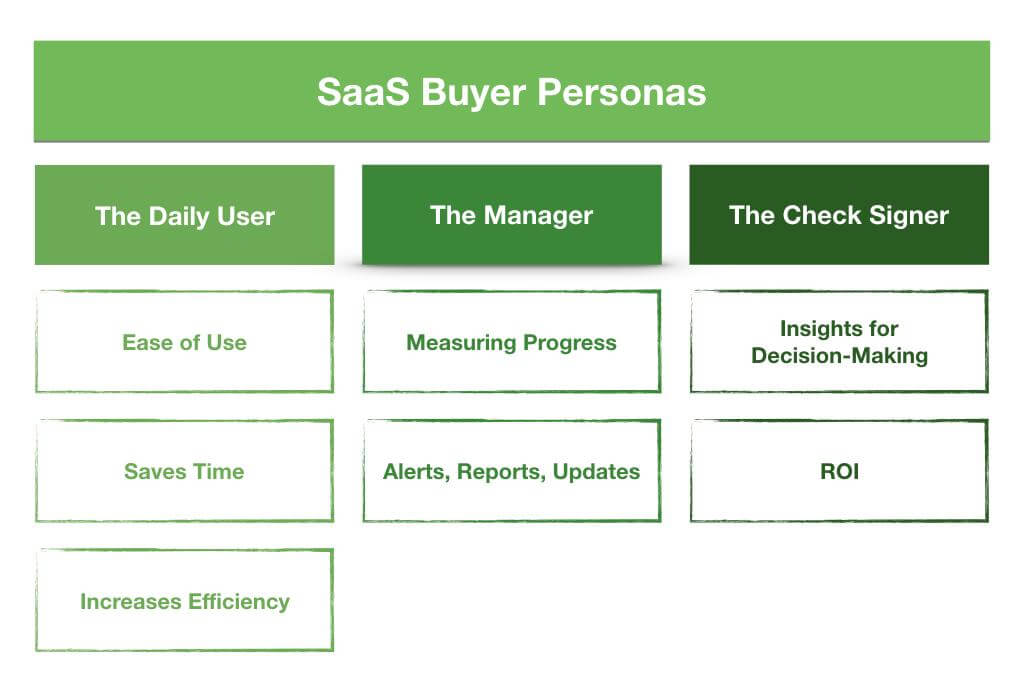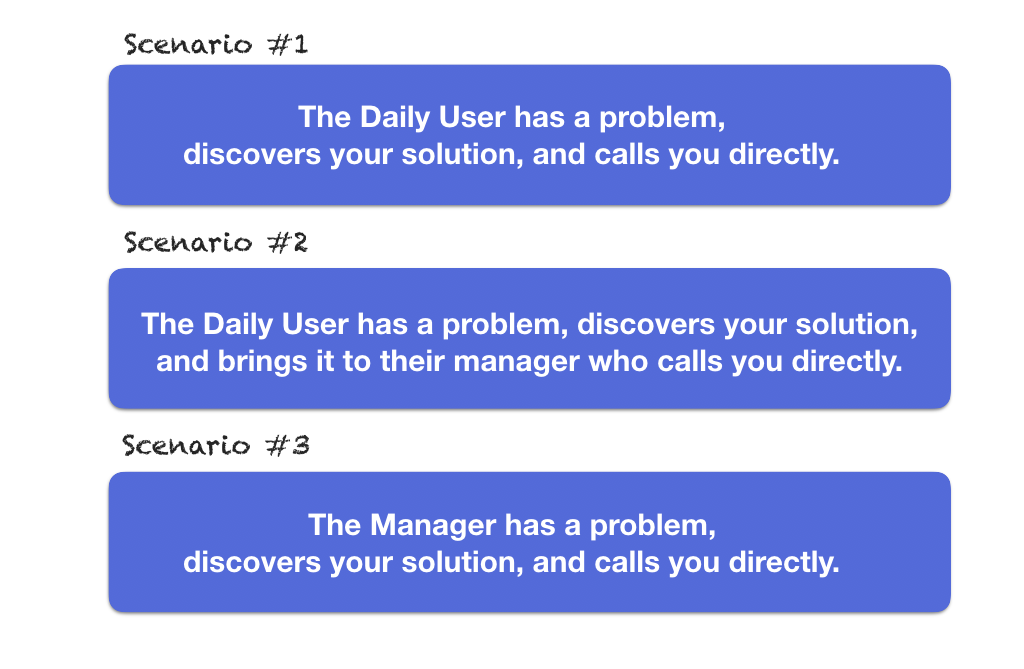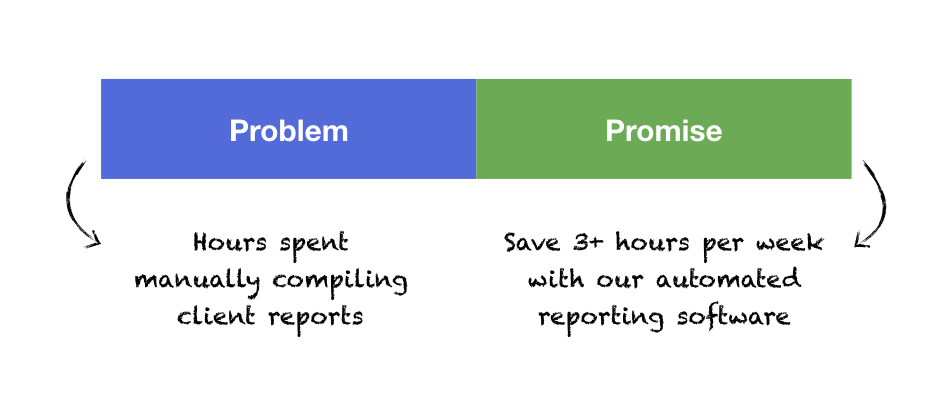How to build B2B SaaS Buyer Personas – and our system for fixing bad personas
Last updated: January 8th, 2024
Here’s a common scenario we see: you’ve gone to the effort and expense to develop your SaaS buyer personas. You’ve created content for your ads and web pages that’s meant to appeal to them. But despite this effort, your conversion rates remain the same.
So what’s going on?
Based on our experience working with dozens of B2B SaaS companies, one of the reasons for this is that with multiple personas in hand, it’s easy to fall into the trap of trying to appeal to each of the stakeholders in your target audience at once.
When you do this, your messaging and content are diluted down such that they are less compelling for any one of the individual personas. Instead of really resonating with one of them, your content and messaging falls short with all of them.
Hence, low conversion rates.
In this article, we’re going to walk you through our approach for how to implement your SaaS company’s personas so they actually work for you.
But before we cover our approach, we have to give a hat tip to the person and concept that our approach is modeled after: Clay Collin’s concept “The 5 One’s”.
Get your Free Marketing Plan here to learn more about how your business can increase MRR by getting your persona targeting right.
A Quick Look at The 5 One’s
Clay Collins famously talked about the concept that the best way to grow a SaaS business is to focus on 5 one’s:
- One target market
- One product
- One conversion tool
- One traffic source
- For one year
Clay’s 5 one’s concept inspired our own approach to implementing personas, which involves figuring out which persona SaaS marketing teams should target first, and gaining traction with them before moving onto target the next one.
The 4 Key Steps to Implement Your SaaS Buyer Personas
Marketing strategies that target multiple personas require a holistic approach. Every element of your marketing from Google Ads, to social media ads, to SEO, and content marketing needs to be tailored to the personas you choose to target.
But if your website isn’t set up right, the rest of your efforts are likely to fall short; so it’s essential to get your website set up to properly target your personas.
As we’ve covered in our article on SaaS website best practices, we like to think about buyer personas as follows:

The Check Signer, The Daily User, and the Manager
Depending on the company size of your target customer, these avatars can be three separate people, or one-to-two people wearing multiple hats (more on how to navigate this below).
And while it might seem like the Check Signer is the obvious first persona to target, the Daily Users and Managers are usually the ones out searching for your SaaS product first.
For example, when we began working with TouchBistro, they’d been targeting restaurant owners (The Check Signer) and were seeing subpar results with their paid ads. By switching to target servers instead (The Daily User), we saw a 200% increase in leads.
Before we dig into our process for choosing who to target first, let’s look at these users more closely:

- The Daily User generally wants a product that’s easy to use, saves them time, and helps them be more efficient.
- The Manager has standards they need to maintain in their areas of responsibility. They typically want things like alerts, reports, and updates to measure progress.
- The Check Signer is mainly concerned with gaining insights that help with decision-making, and seeing that their ROI makes the cost of your product worth it.
This brings us to step #1 in our process.
Step 1: How to Decide Which Persona to Target First
The way we begin to figure out who to target first is by interviewing our SaaS clients to learn:
- Who are their existing customers?
- Who was the first person they were talking with?
- What was the engagement process like when they converted?
We’ll talk to their sales team and also look at their CRM to cross check and make sure the perspectives of the team match the data they’ve collected. From there, we’ll identify which job titles are showing up the most which will help to inform which persona we should start with.
If you sell to larger companies, often the initial target buyer will be either The Manager or The Daily User. There are a number of common ways initial engagements can play out:
Consider these scenarios:

If Scenario #1 or Scenario #3 is the most common case you see in your CRM, things are more straightforward about who to target.
But if Scenario #2 is the most common case leading to sales calls, from the surface it might look like you should target the person who called you (The Manager), but you’d actually want to start with The Daily User because they were the one who discovered you to begin with, and they’re the one who’s problem you solve.
Note on how to discover the truth in Scenario #2: When you’re on sales calls, by asking a question like “So how’d you find us?”, it can help uncover whether the person you’re talking to is who found you or if it came to them from another source.
It’s when you sell to smaller businesses that you encounter the multiple hats scenario, where one person (often the business owner) will play the role of two or all three of the personas. In this situation, you want to try to figure out:
- What percentage of their day do they spend in each of the persona roles (Check Signer mode, Manager mode, and Daily User mode)?
- For the pain points your product solves, which persona are they most directly related to?
Which brings us to Step #2 in our process…
Step 2: How to Decide Which Problem to Target First (The Inverse of that Problem Will Be Your One Promise)
The first thing we do with clients to identify which problem to target first is look at their demo qualification process. We look at what questions they ask to determine if a prospect has a pain point that their product solves, which usually will help us identify which problem to go after.
If our client doesn’t have a well developed qualification process, we’ll use two other resources to help pinpoint the problem:
- Competitors: What are the feature and benefit pages of competitors saying?
- Reviews: What are the reviews (of the client and their competitors) on sites like G2 or Capterra saying?
If you can figure out what people are actually saying they like about your product or your competitors’ products, the problems you are solving for them would be the inverse of those things.
So if you sell reporting software, and the most common thing your customers say they like about your product is that it saves them time from manual reporting, you might determine that the biggest pain point (and the first one to target) is spending hours every week tediously creating manual reports.
What if there are multiple problems to choose from?
Many SaaS services solve multiple problems, and it’s very common for companies to struggle with choosing a single problem to focus on.
Despite this, if you’re serious about putting your personas to work so your messaging and content compel your first target persona, you need to have a decision-making process for choosing the one problem.
Let’s say you’ve identified 3 big problems:
- Lay the 3 problems out on the table.
- Ask yourself, if you absolutely had to get rid of one and narrow it down to 2 problems, which would you get rid of?
- Then, with the 2 remaining problems, do this again. If you absolutely had to get rid of one of these problems, what would be left?
Once you’ve narrowed your focus down to one problem, the inverse of this problem is the promise you’ll make. To continue with our reporting software example from above, if the problem is “hours spent manually compiling client reports each week,” your promise might be “Save 3+ hours per week with our automated reporting software.”

With your one persona, one problem, and one promise in hand, your next step is to set up and launch your campaign to target this first person.
Step 3: Set Up and Launch Your Campaign to Target Your First Persona
All of the work that has been done so far is meant to inform what you’ll say in your ad, what lead magnets you’ll develop for prospects who are earlier in the buyer’s journey, and what your lead magnet and demo landing pages will say.
The advantage of creating these assets with one person, problem, and promise in mind is that you can create focused, compelling messaging around a value proposition that will resonate with your first target buyer.
There is a lot that goes into setting up and launching your campaigns successfully once you reach this point, and we’ve already explained our process for testing paid media channels in detail so that you can get this step right.
Only when we’ve gained traction with this first persona will we launch campaigns targeted at the second persona.
Step 4: Scale to the Next Persona (Usually After About One Quarter)
The key metric we use to decide when it’s time to add in campaigns that target the second most important persona is lead velocity.
Once we see our client’s pipeline filling up with qualified prospects and we see trial downloads or demos have increased, it’s usually a good indicator that targeting a second persona can now add value to our marketing efforts.
Another indicator that it’s time to add in a second persona is if multiple personas are beginning to show up more in sales conversations. For example, if you start with targeting The Manager and you find The Check Signers are consistently coming along too, it’s probably time to begin creating ads and content that help them understand what you offer.
This way when they’re involved in sales conversations they’re more likely to be familiar with your service. And you can avoid the problem that comes up when managers are the ones telling the story of your product instead of you (often not describing it how you’d want them to).
Note: When we begin targeting multiple personas, each has their own ad copy, content, and landing page that is specific to that persona and their pain points. The point is NOT to begin targeting them together (making the mistake this entire process is meant to avoid in the first place).
Conclusion
It’s one thing to have personas developed, and it’s another thing to have them clearly and crisply mapped out on both your website and your advertising so that you don’t dilute your marketing efforts by trying to appeal to multiple personas with the same messaging.
By intentionally creating web pages and ads that target a single persona, and by focusing on gaining traction with one persona at a time, you can make your B2B SaaS personas actually work for you, as opposed to just having them vaguely guide your digital marketing efforts.
Get your Free Marketing Plan here to learn more about how your business can increase MRR by getting your persona targeting right.
What you should do now
Whenever you’re ready…here are 4 ways we can help you grow your B2B software or technology business:
- Claim your Free Marketing Plan. If you’d like to work with us to turn your website into your best demo and trial acquisition platform, claim your FREE Marketing Plan. One of our growth experts will understand your current demand generation situation, and then suggest practical digital marketing strategies to hit your pipeline targets with certainty and predictability.
- If you’d like to learn the exact demand strategies we use for free, go to our blog or visit our resources section, where you can download guides, calculators, and templates we use for our most successful clients.
- If you’d like to work with other experts on our team or learn why we have off the charts team member satisfaction score, then see our Careers page.
- If you know another marketer who’d enjoy reading this page, share it with them via email, Linkedin, Twitter, or Facebook.